Camino de Santiago - French Way - Stage 9 - Nájera to Santo Domingo de la Calzada
Total distance: 21 km
Leave Nájera down the Calle de las Viudas turning right in front of the monastery church and uphill along Calle Costanilla. The road continues uphill into some woods and through some vineyards. After about 6 kilometres you will come across the village of Azofra.
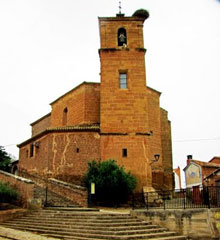
In medieval times Azofra was the site of many pilgrim hospitals and there has been a hostel here since 1168 when it was founded by Isabel la Católica. There is also la Iglesia de Nuestra Señora de los Angeles with a carved statue of Santiago Peregrino inside.
The village has 3 albergues and a couple of restaurants offering a pilgrim menu.
On the outskirts of the village there is a botanical garden and park dedicated to la Virgen de Valbanera, the patron saint of La Rioja, and close by are the remains of the Fuente de los Romeros, a mediaeval pilgrim fountain.
Leave Azofra by going through the park and take a left onto a track and after about 1 kilometre you will come across a rollo or medieval pilgrim cross which marked the border between Azofra and Alescanco. From here the way markers take you through fields and up past the Rioja Alta Golf club into the village of Cirueña.
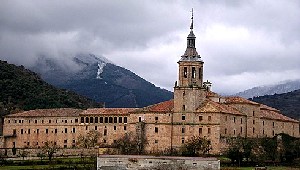
It is worth stating that before you get to Cirueña there are signposts towards San Millán de la Cogilla where you will find the twin monasteries of San Millán de Yuso and San Millán de Suso, a UNESCO world heritage site. However, the site is 20 kilometres off the Camino so if you do wish to visit it's probably advisable to share a taxi.
Coming back to the main Camino continue through Cirueña and along farm tracks until you come to the outskirts of Santo Domingo de la Calzada. Continue along the road and into the centre of the town and its old quarter where you will find an albergue and the cathedral.
The town of Santo Domingo de la Calzada was founded by a young shepherd called Domingo who had tried to join the monastery at San Millán de la Cogilla but was turned away because the young man was illiterate. After failing to enter the monastery he decided to become a hermit and set up his hermitage in some woods on a notorious part of the Camino and administered to the pilgrims who passed this way. A chance meeting with San Gregorio, who had helped rid Los Arcos of a plague of locusts, led Domingo to be ordained a priest.
With the support of King Alfonso VI, who was keen to bring new settlers into the now mainly Muslim region, San Domingo began to build bridges and hostels and built a road between Nájera and Burgos. San Domingo died in 1109 at the age of 90 and became the patron saint of civil engineers.
The saint was initially buried in a tomb at the side of the Camino, which he had built himself, but his admirers later buried him in the cathedral and named the city after him, a title awarded by Alfonso XI in 1334.
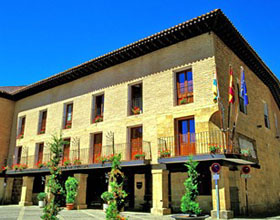
The hospital he built is now a Parador, an expensive 4 star hotel, not quite what Santo Domingo would have intended it to be used for.
Santo Domingo de la Calzada's mediaeval streets have been declared a National Historic Interest Site because of its grand buildings, particularly the Catedral San Salvador and the old pilgrim hospital, its plazas and the city walls, built by Pedro I "The Cruel".
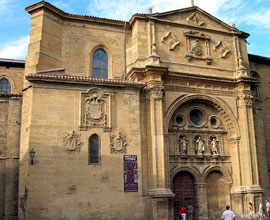
The cathedral of San Salvador dates from the 12th century and is a mixture of Romanesque, Plateresque and Gothic. Inside you will find Santo Domingo's mausoleum. At the rear of the cathedral there is an ornate chicken coup, the permanent home of a cockerel and a hen (which are replaced once a fortnight).
The legend behind the chickens came about through a story begun in the middle ages. It is said that a German family (parents and teenage son) were attempting the Camino and stopped in Santo Domingo for the night. A flirty barmaid took a fancy to the 18 year old son but the boy, probably because he didn't understand the language or was overly pious, was having none of it and turned her down.
The scorned girl sought revenge and placed a silver goblet into his luggage (there are different accounts of exactly what was placed in the bag, some say it was a bag of money others say it was a chalice from the church). The next morning the goblet was discovered missing and the barmaid accused the young German boy of stealing. The boy's luggage was searched and the goblet found and he was promptly brought before the local judge, found guilty and hanged.
The grief stricken parents continued on their pilgrimage and upon arriving at Santiago de Compostela, prayed to St James for the soul of their son. On their return journey they again decided to stay the night in Santo Domingo de la Calzada. Upon reaching the town they were surprised to find that their son was still hanging from the gibbet and more surprisingly, that he was still alive.
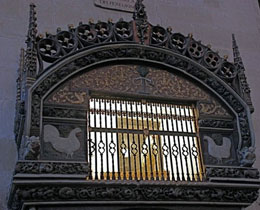
The parents rushed to see the judge and explained what they had seen. So incensed was the judge that they had the audacity to interrupt his dinner that he proclaimed “your son is about as alive as these roast chickens I am about to eat”. At that moment the two birds jumped off the plate and began to fly, so proclaiming the boy's innocence.
In memory of this miraculous event a snow white cockerel and a hen, donated by local farmers, have been kept in the ornate gothic henhouse in the cathedral ever since.
There are a number of houses on the main street, the Calle Mayor, worth visiting as well as the City Hall and Convento de San Francisco. Because of its position along the Camino de Santiago there are a number of religious monuments and Ermitas all around the town.
Like many large towns you will find all the necessary facilities. There are 2 albergues and at very busy periods the city council allows pilgrims to sleep in the sports hall. The Casa de Santos is the Pilgrims information office.

